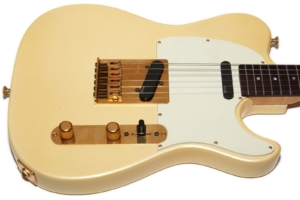
Being a Guild collector, though, when a Guild T250 guitar came up for sale I had to buy it to see if my favorite guitar brand could somehow change my mind about the venerable Telecaster. Let’s take a look at this relatively uncommon Guild electric guitar.
Introduction
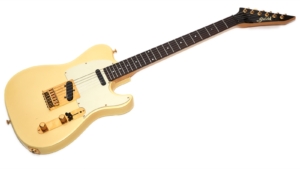
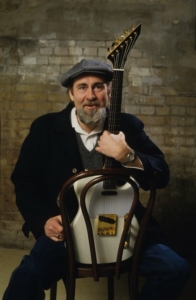
Roy Buchanan never came to the forefront of fame like those he inspired. As a dopy hair-band lover in the ’80s he was outside my realm of notice because as much as I love and have always loved Guilds, in the late 1980s I was chasing the tone of guys like Eddie Van Halen and George Lynch while lusting after guitars from Jackson and Charvel. I was never a Tele player, and though I’ve always loved the blues, I was sadly just too mainstream to have discovered Roy Buchanan. By the way, I borrowed this picture of Roy with what appears to be a Guild T250 from this excellent collection. I encourage you to take a look. You may also wish to check out this old-school webpage I found on AltaVista of all places which seems to have a fair bit of information collected on Roy Buchanan.
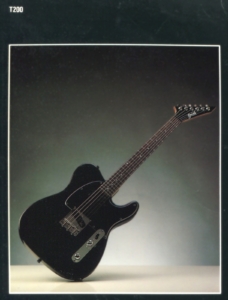
Technically, the Guild T250 is not a Roy Buchanan model. In the 1986 price guide there is a T200 Roy Buchanan model listed with a list price of $799. All it says in the description is 1 H.B., 2 Single Coils which does not match the picture in the catalog for that year, but then Guild isn’t known for it’s super-accurate price lists or catalogs. From what I can tell looking at the picture in detail, there are not three pickups and the bridge pickup is not a humbucker, though I suppose it’s possible that it’s a stacked coil design. I think it’s more likely that the price list is just wrong though I can only assume based on the data at my disposal, which admittedly isn’t much to go on.
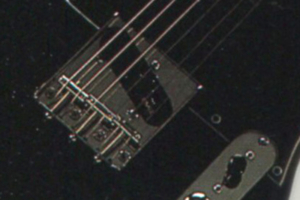
I don’t recall ever seeing a T200 in the wild which is a shame because I think the chrome parts are much more in line with the telecaster shape than the gold parts found on the T250. With the old-style bridge and saddles the T200 could have been a Guild Tele that people would have probably liked, except for the terrible headstock choice which probably seemed like a good idea back in the mid-late 1980s.
The Guild T250 is not a Roy Buchanan model, and when I originally wrote this piece I thought it was but thanks to this thread on the LetsTalkGuild forum, I was set straight and changed this article a bit. The proof is in the 1987 price guide shown to the right which has not reference to Roy Buchanan in the description of the T250. I think I must have succumbed to the Internet misconception that Roy Buchanan and the T250 are connected because I think every T250 I see mentioned online has Roy’s name along with it.
I would have declared that one of the defining features of the Guild T250 was gold hardware since that’s all I ever see, but the 1987 price list seems to indicate that the gold hardware came as an option when EMG pickups were included. I’ve only ever seen one T250 with chrome in the wild (which I’ll talk about in a bit) aside from the one in the catalog which is a shame because I really like the look of chrome on this guitar. Once again a major instrument manufacturer went and designed a guitar without getting my input. Crazy, right?
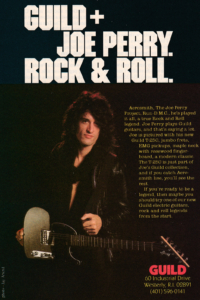
Note that nowhere on this ad does the name Roy Buchanan appear which may add credence to the theory that Roy was angry with Guild for not using his name when advertising the guitar he helped to design. It certainly adds to the proof that I was wrong to originally call the guitar a Roy Buchanan.
I’ve shown Joe Perry with Guilds before, notably with his S284 Aviator. I loved Aerosmith in the ’80s and I’ve always loved Guilds and I’m honestly kind of shocked to see how many Guilds he had. I guess I was too busy chasing girls practicing to notice.
I had never seen a T250 with anything but EMG pickups until my online research led me to this page which shows not only Dimarzios but a very welcome cake-knife headstock! Holy crap – it’s perfect! If you’re reading this and happen to own the black and white T250 I’m about to talk about, please sell it to me!
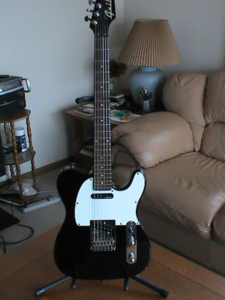
Regardless of the historic details, so far as I can tell the T200 and T250 guitars are the only Telecaster-type electric guitars that Guild ever made (at least that I could find). One could argue that the Crossroads CR01 might be included in that list but that guitar has a very different design and is really only Tele shaped.
As I already wrote, the T250 doesn’t seem to have a great reputation among Telecaster lovers, so let’s see how it fares when evaluated by this Guild lover who’s never been a fan of Teles.
Finish
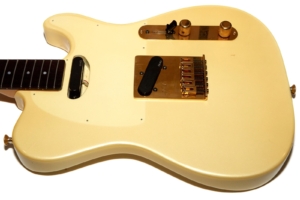
I could also not find a list of colors offered for the T250 when it was sold. I have seen them in black, sort of a Pelham blue, a seafoam green, red, and this ivory color, but since I couldn’t find an official document describing options that may not be an inclusive list.
My guess for this guitar is that it’s finished in poly but there are no wear points or indications of what the finish might be apart from feel and I’ve felt plenty of both finishes to know that it’s not a good indication of type. I’ve also been wrong before.
Fretboard and Neck
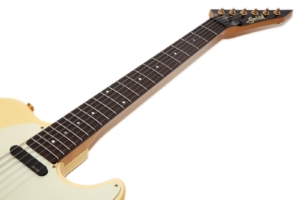
The frets measure .10″ wide by .04″ high making them jumbos, but I should point out that this guitar has been refretted with stainless frets which not only adds a huge amount of durability, but also increases the brightness or chime of the guitar making it arguably even more Tele-like than when it left the factory.
I see some conversations online about these guitars with people saying that they have flat fretboards that are probably 12″ or more. The fretboard radius on the one in my hands as I write this is a solid 9.5″. Though it’s possible that the fretboard was reradiused when the new frets were installed, if that was done it was a masterful job as I see no signs of that.
Having the longer scale imparts a higher tension on the strings (given the same tuning) and also makes the timbre of the instrument have a ring or chime to it that is a huge part of the Telecaster sound. The neck is maple and the fretboard is unbound rosewood with simple dot inlays.
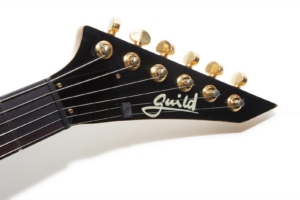
Build Quality
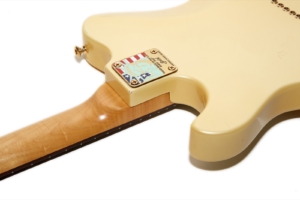
This guitar weighs 8 lbs 6 oz (3.8 kg) which is pretty heavy to me, but it is a big ol’ hunk of poplar with a maple neck and a solid brass bridge, so I suppose it could be worse.
Pickups
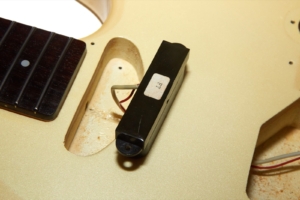
From what I can tell FT stands for Front Telecaster while the comparison pickup would be the RT for Rear Telecaster. I’ve never heard pickups referred to as front and rear before and it took me a while to figure out that EMG had named them as such.
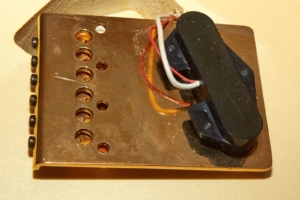
I’ve seen some comments online that the Tele pickups are EMG’s best pickups and I have to say that I was pretty pleasantly surprised by them in this guitar with one possible exception that I cover in the Sound section.
Electronics
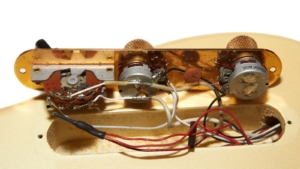
The wiring in this guitar seems to have been fiddled with by someone, though the only obvious points that stand out are the fact that there are solder blobs on the tone pot which are otherwise not being used and the fact that there is a .047 mF capacitor in the circuit where I’d normally expect to see a .01 mF in an EMG circuit. The guitar was sold to me as having an aftermarket EMG Mid-Boost installed, but there is no such animal in the circuit so maybe someone got sold on a .047 mF cap being a “mid boost”. It’s also possible that the pickups are not original so bear that in mind when considering this wiring.
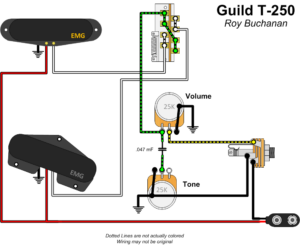
About the only thing that’s really different about this guitar from a normal Tele is the fact that it’s got active pickups so there is the inclusion of a battery in the mix. The guitar has a nicely routed chamber for the battery, but you do have to remove screws to access it. That’s still a lot better than having to remove the pick guard, though on a guitar like this there wouldn’t be any room for a battery in there, anyway.
Hardware
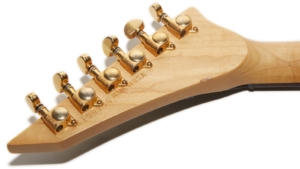
The tailpiece is brass and quite heavy and the saddles are of the type that I generally dislike on Fender guitars, though to be fair they function fine – I just hate the way they look.
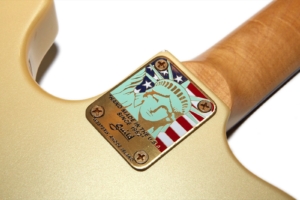
The hardware is all of top-notch quality, but as I’ve already stated I personally feel that gold hardware has no business on a Tele-type guitar. A Tele is a working man’s guitar as driven home endlessly on the radio by Bruce Springsteen during the ’70s and ’80s. Certainly, the American Deluxe Telecaster by Fender adds some bling to the Tele with stuff like body binding and pearloid pick guards, and there are some custom shop Teles out there with gold hardware, but I think it looks odd.
Then again, if gold hardware on a Tele was good enough for Buck Owens or, you know, Roy Buchanan, then who am I to judge? Oh wait – this is not a Roy Buchanan model!
Sound
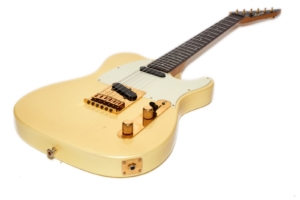
The other obvious difference is the pickups since they are active EMGs, but where EMG humbuckers can sound sterile I didn’t get that vibe from this guitar which could be why so many people consider these to be the best pickups EMG ever made. I don’t have enough experience with different EMG models to make that claim, but I will say that I was pleasantly surprised at the tone from this guitar.
ODS100 Clean
Open Chords #1
Open Chords #2
7th Chords
D-Shape
JCM-800
A Barre Chords
D-Shape
Citrus
D-Shape
USA Clean
Open Riff
I should start by saying that I’m not completely happy with the recordings, specifically on the JCM800 patch. I’m not entirely sure what happened there because I use the same rig down to the cable for every rundown which leads me to believe that this issue has to be the guitar. It’s quite possible that the guitar just doesn’t interact well with the Axe-FX on that setting which is unfortunate because I expected it to sound killer.
I really like the guitar on the clean amp sounds which is why I added a USA clean recording. I also liked the guitar a lot on the Citrus setting so the guitar is not afraid to play with high gain; it just didn’t seem to get along with the JCM800.
Overall I liked the sounds that this guitar could produce and thought that it was sufficiently Tele-sounding to my non-Tele-guy ears. I’m mostly a humbucker player but when you need that Fenderish sound then you need the right guitar and the T250 will get you there.
Because I’m primarily a humbucker guy I often find that Teles can get damn-near unpleasant sounding when pushed with the bridge pickup and I felt that way with this one, too. I imagine pairing it with the right amp would make all the difference in the world.
Finally, I have to point out that this guitar is an absolute sustain monster and a strummed open chord just rings and rings. That was actually one of my favorite aspects of this guitar during my testing.
Playability
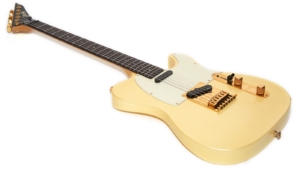
Another change from a traditional tele when it comes to playability is the bridge. The bridge feels very different from a vintage tele because it doesn’t have the whole ashtray thing going on so it doesn’t have the ridge around the outside. I’ve never liked that ridge, but if you’re expecting the feel of a vintage Tele that’s probably going to annoy you. Similarly, the saddles are more modern than the vintage design and though they work just fine, they’re different. It actually feels just like a modern American Standard Telecaster because the bridge and bridge plate are both pretty much the same, so if that’s what you’re used to then you’re in luck here.
The biggest issue for me on this guitar is the lack of a forearm bevel but then I guess that makes me a wuss. It’s also not that much of a problem except if I play it for long periods of time after which my arm goes numb. That could very well be due to my multiple martial arts injuries that required surgery so your mileage may certainly vary.
The guitar is slightly neck-heavy which is really only a problem for me because my favorite strap is a nice leather El Dorado that’s slippery. With a grippier strap the guitar stays put just fine.
Conclusion
This is absolutely a quality guitar in every way. Sadly it suffers from some odd design decisions which are either thanks to Guild (it wouldn’t be the first time) or maybe Roy Buchanan. It’s also very possible that it’s due to a combination of both.
Sure, I think the gold hardware looks goofy on a Tele and the pointy headstock is a deal breaker for a lot of people, but neither of those things affect the playability or sound. It’s a little odd having active pickups in a Tele, but I was surprised at how much I liked them and was also surprised that this guitar delivers the Tele spank that is the hallmark of the design.
I think this guitar suffers most from not fitting into people’s molds. It’s not vintage correct enough for a lot of Tele lovers, and it’s not really Guild enough (whatever that means) for Guild lovers who chase Bluesbirds, S100s, or S200s for that matter. Its pointy headstock makes it easy to revile by the hoards of people that hate pointy guitars, and it’s got a rosewood fretboard so purists have one more reason to say no. All of that is a shame, though, because this really is a great guitar.
Where those design missteps can play into your benefit is that you might just find one in a pawn shop somewhere for a great price and if you do, I suggest you give it a chance. You might just fall in love with this pointy headstock mostly Tele-like Guild.
Donate: PayPal Crypto:
ETH: 0x0AC57f8e0A49dc06Ed4f7926d169342ec4FCd461
Doge: DFWpLqMr6QF67t4wRzvTtNd8UDwjGTQBGs

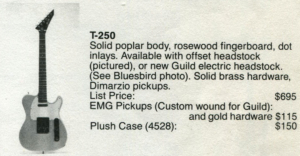



Hi I enjoyed reading about your Guilds. I am not being picky but you said in the Guild article on the Guild T-250 – The Not Roy Buchanan Guild Tele that these are the only Tele Guilds that they made but this is a EG71Cr. I believe factory original except the prior owner reshaped the headstock and put a Fender label on it.
It does play amazingly well and as you said about the T-250, this is a sustain monster. Have you ever seen this model?? I can send photos if you wish. Thanks God Bless Hope you and your kids are well.
I’m not familiar with that model number. Is it a crossroads? I’d love to see pics.
I stumbled on a Guild T250 oddly enough in southern New Jersey. Mine is all chrome. It has passive Seymour Duncan pickups though the body is routed for the d battery for active EMGs. No way of tracing the guitar further. I purchased it from a pastor who explained that it was left in exchange for money owed on an auto repair at a garage owned by someone in his flock.
If you are interested in seeing photos (I posted one on the Guild owners and fans Facebook Page) let me know. I very much enjoyed your article. Thanks!
I saw your post there. Pretty cool. They’re surprisingly great guitars. I think they would have been more popular with a less polarizing headstock.
Hi GAD,
I owned a black with white pickguard T200 years back and ended up selling it to Hans on eBay.
I believe less than 25 T200’s were made. The distinction if a T200 and T250 is the size of the cutaway horn. The T200 has the longer horn and body shape is closer to a Tele than the more modestly shaped (which I like) T250. Mine had gold hardware and EMG pickups and the pointy headstock which I though didn’t go well with the body style of the T200 (or T250). Mine also had a elementary bridge design that used rolled metal saddles with symmetric mini allen screws on either side of the string to adjust the height of the saddle and then a long machine screw running through the back of the “flat” ashtray hole, then through a “pen” spring and screwing into the saddle. You adjusted intonation of each string independently with that hardware. So it was different from the traditional Tele bridge you showed but not the modern bridge saddle assembly of the T250’s.
Finally mine had a low serial number but can’t recall what it was. However it did not have Roy B’s name in the TRC.
M
Thanks for commenting – that’s some cool history!
I have a black T250 w/o the liberty back plate. Gold with the emg’s. plays great. Did they only put the liberty back plate on for a short time?
I have a Guild T250 Blue with what they called the new Headstock (not the slanted one.) It was available then with either. I found the original price page for this guitar also. Mine does not have the active pickups. It does have the Statue of Liberty back plate. I bought it new somewhere around 1988. It is my favorite guitar.
Hi,
Did you ever try the Roy Buchanan Bluesmaster No 6 ? Had the sound of a Gibson, Stratocaster and telecaster in one Roy said.
Interesting guitar anyway.
I owned a T-200 a while back. It appeared identical to your guitar (blonde, droopy headstock, gold/brass) in all respects other than
*Truss Rod Cover read “ROY BUCHANAN”
*Neck plate was not the USA one, but plain black, IIRC
*Switch tip was not a top hat, but more of a strat style
Serial number was HK 101010.
Correction, serial number was HK 100024
Hey GAD,
One other thing…
I had heard that Roy B was upset with Guild because Guild didn’t pay him a lot of money for the endorsement. Roy’s career was on significant decline at the time and the endorsement amount wasn’t what Roy was anticipating.
M
Sorry GAD,
Three other items.
1)The T200 used a standard black metal plate to secure the neck to the body. My sunburst T250 has the Lady Liberty neck plate.
2) 1986 was the recommisioning of the Statue of Liberty. It had fell into disrepair and was closed for safety reasons. Lee Iococca, of Ford Mustang fame and as the CEO of the post bankruptcy “new Chrystler AMC corporation” and minivan, had led a National fund raising effort to restore the Statue of Liberty. Companies that contributed to the Lady Liberty restoration wher allowed to use that special logo in their advertising.
So on July 4, 1986, the restored Statue of Liberty was opened and dedicated during the large celebration and fireworks display in NYC. Lee Iococca spoke at that dedication.
I was on my honeymoon in HI and watched the celebration on TV from HI.
It’s a little sad that the restoration of the Statue of Liberty may have been forgotten by many. Funding for memorials do not come out of our taxes. They require private funding.
3) Guild also offer a T250 version that came with a stacked humbucker pickup. I have in my possession a stacked humbucker Tele bridge pickup made by DiMarzio with a black plastic pickup cover with Guild printed in white on the top of the cover. I also have a standard size SC stacked humbucker pickup made in a similar manner by DiMarzio with black plastic cover with Guild printed in white on top of the cover.
M
I have one of those stacked pickups. I always wondered what it was for.